Multiple Sclerosis: Market Size, Trend, by Treatment Type (Disease-Modifying Therapies (DMTs), Symptomatic Treatments, Corticosteroids), by Disease Type (RRMS, PPMS, SPMS, PRMS), by Drug Class (Immunomodulators, Immunosuppressants, Monoclonal Antibodies, Corticosteroids) Route of Administration (Oral, injections), End Users, Distribution Channels, Region, Major Players – Global Forecast to 2030
DESCRIPTION
Wissen Research analyses that the global multiple sclerosis market is estimated at USD 27.6 billion in 2024 and is projected to reach USD 38 billion by 2030, expected to grow at a CAGR of 6% during the forecast period, 2025-2030.
Key driving factors of multiple sclerosis market include rising prevalence of infectious disease, increasing investments in advanced neurological treatments and expanding healthcare infrastructure and improved accessibility to specialized neurological care.
Challenges in the multiple sclerosis domain include high treatment costs and limited insurance coverage and complex disease progression. immunosuppressants have held the most significant share in the market since 2022, with North America dominating the regional market share.
Key players functioning in multiple sclerosis sector are Teva Pharmaceuticals Industries Ltd, Johnsons & Johnsons, Merck, Biogen, Pfizer and Bayer AG.
Further, the US with USD 11 billion market in 2024, holds majority share in the global multiple sclerosis market and is likely to remain the leading region growing a CAGR of 6.2% within this market, during the forecast period.
LUCRATIVE OPPORTUNITIES IN THE MULTIPLE SCLEROSIS MARKET
Global multiple sclerosis market is anticipated to reach USD 38 billion by 2030 from USD 27.6 billion in 2024, growing at an annualized rate of 6% during the period, 2025-2030 | Emerging economies such as India, China, Brazil, South Africa, and Turkey present significant growth opportunities for the Multiple Sclerosis (MS) market due to rising prevalence rates and increasing awareness of neurological disorders. While MS prevalence remains lower in these regions compared to Western countries, factors like improved healthcare infrastructure, growing access to diagnostic tools such as MRI, and the introduction of advanced disease-modifying therapies are driving market expansion. Additionally, targeted investments in research and development are fostering innovative treatment approaches tailored to regional needs. | ASIA-PACIFIC Rising awareness, increasing healthcare investments, and a growing prevalence of neurological disorders in emerging countries is expected to provide lucrative opportunities for market players. |
Multiple Sclerosis (MS) treatment landscape has advanced significantly, with disease-modifying therapies (DMTs) playing a central role in managing the condition. FDA-approved DMTs, such as ocrelizumab for primary progressive MS and siponimod for active secondary progressive MS, have demonstrated efficacy in slowing disease progression and reducing relapses. Additionally, experimental approaches like stem cell transplantation and remyelination therapies are being explored to address neurodegeneration and promote recovery in progressive forms of MS | Emerging markets in Southeast Asia and Latin America are driving growth in the Multiple Sclerosis (MS) sector due to increasing healthcare investments and improved access to treatment options. In Southeast Asia, rising incomes and government-backed initiatives are boosting demand for advanced therapies, including disease-modifying treatments and rehabilitation services. Similarly, Latin America is witnessing enhanced healthcare infrastructure and collaborations with global pharmaceutical companies, creating opportunities for innovative and cost-effective solutions to address the unmet needs of MS patients. |
Multiple Sclerosis (MS) treatment landscape has advanced significantly, with disease-modifying therapies (DMTs) playing a central role in managing the condition. FDA-approved DMTs, such as ocrelizumab for primary progressive MS and siponimod for active secondary progressive MS, have demonstrated efficacy in slowing disease progression and reducing relapses. Additionally, experimental approaches like stem cell transplantation and remyelination therapies are being explored to address neurodegeneration and promote recovery in progressive forms of MS | Emerging markets in Southeast Asia and Latin America are driving growth in the Multiple Sclerosis (MS) sector due to increasing healthcare investments and improved access to treatment options. In Southeast Asia, rising incomes and government-backed initiatives are boosting demand for advanced therapies, including disease-modifying treatments and rehabilitation services. Similarly, Latin America is witnessing enhanced healthcare infrastructure and collaborations with global pharmaceutical companies, creating opportunities for innovative and cost-effective solutions to address the unmet needs of MS patients. |
|
Drivers: Rising prevalence of Multiple Sclerosis globally
The prevalence of multiple sclerosis (MS) is increasing globally, with approximately 2.8 million people living with the disease as of 2020, according to the Multiple Sclerosis International Federation (MSIF). This represents a prevalence rate of 35.9 cases per 100,000 people worldwide, reflecting a rise from previous estimates. Factors contributing to this increase include improved diagnostic techniques, greater awareness, and potential environmental and genetic influences.
This growing prevalence is driving demand for advanced diagnostics, innovative therapies, and supportive care solutions, spurring growth in the MS market.
Opportunities: Increased investments in clinical trials and R&D
The growing investments in clinical trials and research and development (R&D) represent a significant market opportunity in the multiple sclerosis (MS) industry. In recent years, pharmaceutical companies and research institutions have significantly ramped up funding to develop advanced therapeutics, including oral drugs, biologics, and cell-based therapies. For instance, as of 2022, the number of ongoing clinical trials for MS surpassed 200 globally, with major players like Biogen, Novartis, and Roche leading the charge in exploring groundbreaking treatments. This surge in clinical research reflects both the unmet medical need and the confidence in the potential for innovative therapies to address the diverse challenges of MS management.
Additionally, the National Multiple Sclerosis Society (NMSS) alone has invested over $1 billion in MS research since its inception, underscoring the global commitment to advancing therapeutic options. This focus on R&D has led to significant milestones, such as the development of high-efficacy therapies like Ocrevus (ocrelizumab) and advancements in remyelination and neuroprotection strategies.
Challenges: High treatment costs and limited insurance coverage for specialized MS therapies
High treatment costs and limited insurance coverage pose a significant challenge in the multiple sclerosis (MS) market, restricting patient access to advanced therapies. The annual cost of disease-modifying therapies (DMTs) now exceeds $80,000 per patient in the U.S., with newer treatments like Ocrevus priced at over $65,000 annually. Despite their efficacy, over 40% of patients face insurance-related hurdles in accessing these medications, leading to delays in care and financial burdens. For many, out-of-pocket expenses can consume 20-30% of annual income, highlighting the urgent need for more affordable solutions and equitable coverage to improve treatment access and outcomes.
MARKET DYNAMICS
Drivers: Rising prevalence of Multiple Sclerosis globally
The prevalence of multiple sclerosis (MS) is increasing globally, with approximately 2.8 million people living with the disease as of 2020, according to the Multiple Sclerosis International Federation (MSIF). This represents a prevalence rate of 35.9 cases per 100,000 people worldwide, reflecting a rise from previous estimates. Factors contributing to this increase include improved diagnostic techniques, greater awareness, and potential environmental and genetic influences.
This growing prevalence is driving demand for advanced diagnostics, innovative therapies, and supportive care solutions, spurring growth in the MS market.
Opportunities: Increased investments in clinical trials and R&D
The growing investments in clinical trials and research and development (R&D) represent a significant market opportunity in the multiple sclerosis (MS) industry. In recent years, pharmaceutical companies and research institutions have significantly ramped up funding to develop advanced therapeutics, including oral drugs, biologics, and cell-based therapies. For instance, as of 2022, the number of ongoing clinical trials for MS surpassed 200 globally, with major players like Biogen, Novartis, and Roche leading the charge in exploring groundbreaking treatments. This surge in clinical research reflects both the unmet medical need and the confidence in the potential for innovative therapies to address the diverse challenges of MS management.
Additionally, the National Multiple Sclerosis Society (NMSS) alone has invested over $1 billion in MS research since its inception, underscoring the global commitment to advancing therapeutic options. This focus on R&D has led to significant milestones, such as the development of high-efficacy therapies like Ocrevus (ocrelizumab) and advancements in remyelination and neuroprotection strategies.
Challenges: High treatment costs and limited insurance coverage for specialized MS therapies
High treatment costs and limited insurance coverage pose a significant challenge in the multiple sclerosis (MS) market, restricting patient access to advanced therapies. The annual cost of disease-modifying therapies (DMTs) now exceeds $80,000 per patient in the U.S., with newer treatments like Ocrevus priced at over $65,000 annually. Despite their efficacy, over 40% of patients face insurance-related hurdles in accessing these medications, leading to delays in care and financial burdens. For many, out-of-pocket expenses can consume 20-30% of annual income, highlighting the urgent need for more affordable solutions and equitable coverage to improve treatment access and outcomes.
Immunosuppressants dominated the multiple sclerosis drug market in 2023
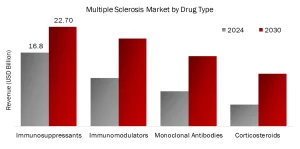 Multiple sclerosis treatment includes various drug classes, including immunosuppressants, immunomodulators, monoclonal antibodies, corticosteroids among others. Each category serves a different mode of disease management. Among these, immunosuppressants have held the largest market share. Key immunosuppressive drugs like Ocrevus (ocrelizumab) and Tysabri (natalizumab) have gained significant market share in the MS treatment landscape due to their efficacy and safety profiles. Medications like fingolimod (Gilenya) and dimethyl fumarate (Tecfidera) have been widely adopted due to their oral administration and proven effectiveness in reducing relapses.
Multiple sclerosis treatment includes various drug classes, including immunosuppressants, immunomodulators, monoclonal antibodies, corticosteroids among others. Each category serves a different mode of disease management. Among these, immunosuppressants have held the largest market share. Key immunosuppressive drugs like Ocrevus (ocrelizumab) and Tysabri (natalizumab) have gained significant market share in the MS treatment landscape due to their efficacy and safety profiles. Medications like fingolimod (Gilenya) and dimethyl fumarate (Tecfidera) have been widely adopted due to their oral administration and proven effectiveness in reducing relapses.
Moreover: Patent expirations for some older drugs (like Copaxone) and the rise of biosimilars have created opportunities for more affordable treatment options, although biologics like Ocrevus still dominate.
Injectables accounted for the largest share in multiple sclerosis market by Route of Administration in 2023
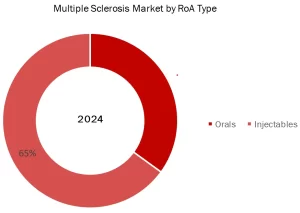 Global Multiple sclerosis market by application is segmented into multiple RoA types, these are oral and injectables.
Global Multiple sclerosis market by application is segmented into multiple RoA types, these are oral and injectables.
Among the aforementioned RoAs injectables segment dominated the market due to rising preference for injectables due to higher efficacy and convenience, long-term clinical data and established efficacy, Its affordability and accessibility and its established prescribing habits and physician comfort
Significant market share held by hospitals was observed in 2023
Various distribution channels are employed in global MS market such as hospitals, retail pharmacies, online pharmacies, among others.
The traditional healthcare facilities, i.e. hospitals remained the significant holder of distribution channels market share due to growing significance of disease and the rise in number of indoor patients.
North America held the largest market share in Multiple Sclerosis in the forecast period
Multiple sclerosis market research included a comprehensive analysis of five key regions:
All regions were evaluated based on these following factors- healthcare infrastructure, regulatory landscape, technological adoption, and market dynamics.
The research observed that North America held the largest share in the multiple sclerosis treatment market domain during the forecast period, primarily due to its advanced healthcare systems, high adoption rates, and the presence of major market players driving innovation in this sector.
PROMINANT PLAYERS WITHIN MULTIPLE SCLEROSIS MARKET
Major players operating in multiple sclerosis market are:
BRAND ANALYSIS: MULTIPLE SCLEROSIS MARKET

Sources: Secondary Research
PRIMARY INSIGHTS FROM KEY OPINION LEADERS
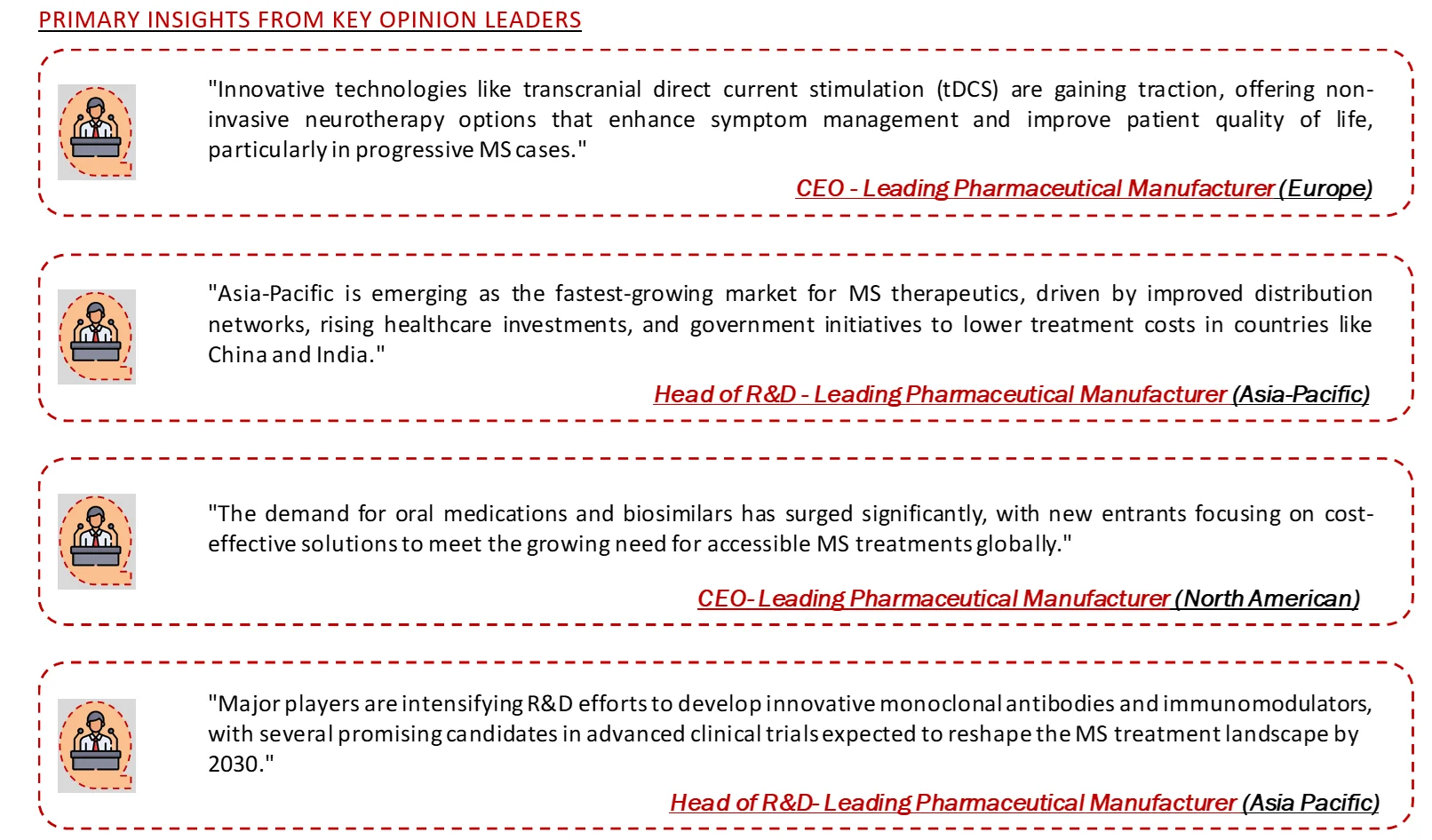
Sources: Primary Research and Wissen Research Analysis.
Note: Above mention is non-exhaustive samples of the primary insights.
MULTIPLE SCLEROSIS MARKET SUMMARY
Particulars | Details |
Report | Multiple Sclerosis Market |
Forecast Period | 2025-2030 |
Base Year | 2024 |
Format | |
Estimated Market Size (2023) | USD 27.6 Billion |
CAGR (2024-2030) | 6% |
Number of Pages | 170 |
Number of Tables | 161 |
Number of Figures | 33 |
Key Segments | Multiple Sclerosis Market Treatment Outlook (Disease-Modifying Therapies (DMTs), Symptomatic Treatments, Corticosteroids)
Multiple Sclerosis Market Disease Outlook (Relapsing-Remitting Multiple Sclerosis (RRMS), Primary Progressive Multiple Sclerosis (PPMS), Secondary Progressive Multiple Sclerosis (SPMS), Progressive Relapsing Multiple Sclerosis (PRMS)
Multiple Sclerosis Market Drug Class Outlook (Immunomodulators, Immunosuppressants, Monoclonal Antibodies, Corticosteroids) Multiple Sclerosis Market Route of Administration Outlook (Oral, Injections) Multiple Sclerosis Market End User Outlook (Hospitals and Clinics, Outpatient Care Centers, Others (Homecare, Research institutes, etc.) Multiple Sclerosis Market Distribution Channels Outlook (Hospitals Pharmacies, Retail Pharmacies, Online Pharmacies) |
Regions Covered |
|
Key Players Covered (Majority Share Holders) | Pfizer (US), GSK plc (UK), Merck & Co (Germany), Pfizer (US), Bayer AG (Germany), Sanofi (France), Johnson & Johnson (US), Novartis (Switzerland), Takeda Pharmaceuticals Company Limited (Japan), Bristol-Myers Squibb Company (US), Biogen (US), Teva Pharmaceutical Industries Ltd. (Israel), Horizon Therapeutics plc (Ireland) |
Introduction
Market Definition
Multiple sclerosis (MS) is a chronic autoimmune disease that affects the central nervous system, specifically the brain and spinal cord. It occurs when the immune system attacks the protective covering of nerve fibers (myelin), causing communication issues between the brain and the rest of the body. Symptoms vary but may include fatigue, muscle weakness, vision problems, and coordination difficulties. MS can progress over time or present in relapsing-remitting episodes. While its exact cause is unknown, genetics and environmental factors play a role. Though there is no cure, treatments like immunotherapy and lifestyle adjustments can help manage symptoms and slow disease progression
FIGURE: MULTIPLE SCLEROSIS MARKET SEGMENTS
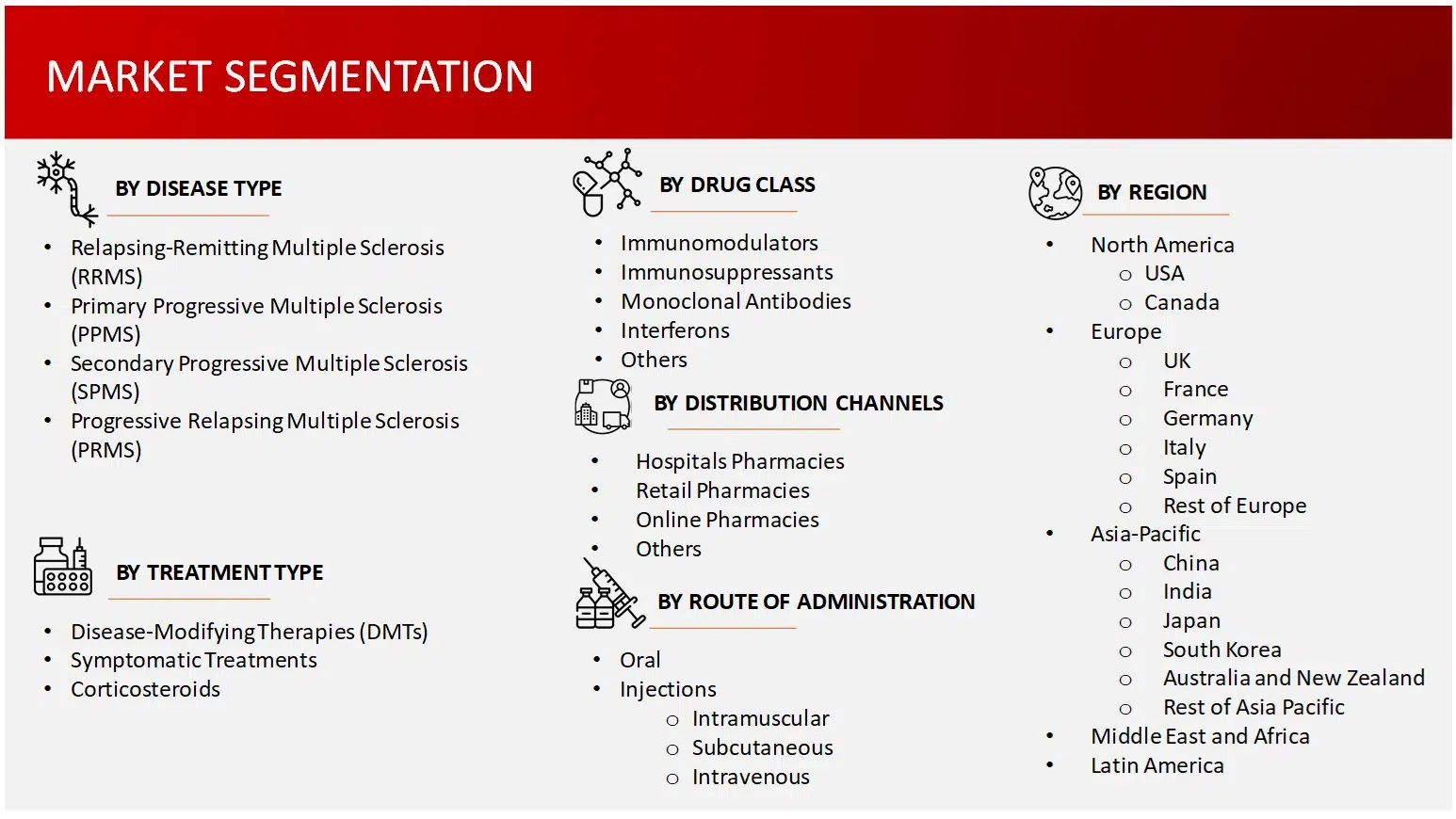
Sources: Company Websites and Wissen Research Analysis
FIGURE: YEARS FRAMEWORK CONSIDERED IN THE STUDY
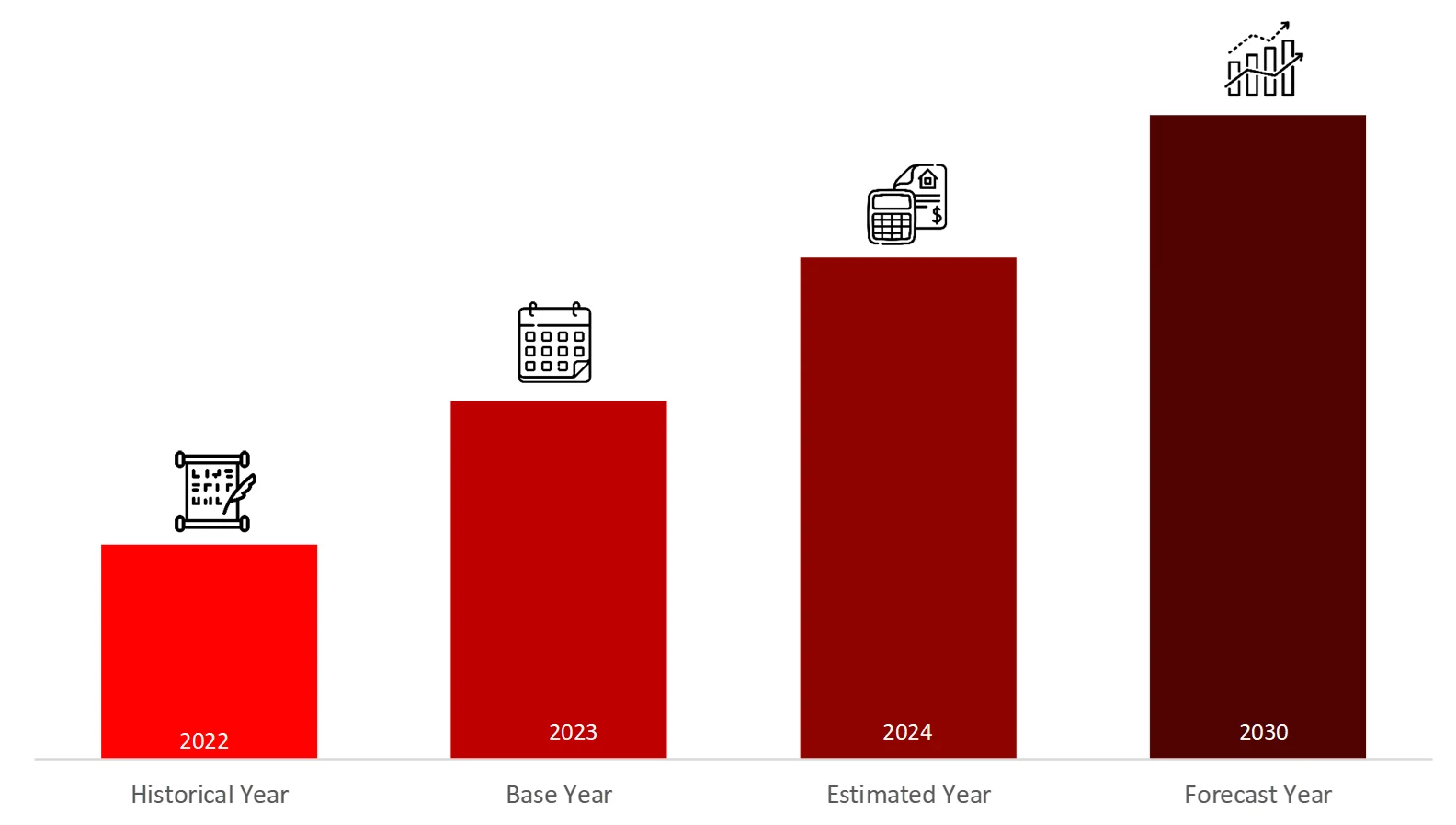
Sources: Wissen Research Analysis
Key Stakeholders
Key objectives of the Study
Research Methodology
The objective of the study is to analyze the key market dynamics such as drivers, opportunities, challenges, restraints, and key player strategies. To track company developments such as product launches and approvals, expansions, and collaborations of the leading players, the competitive landscape of the multiple sclerosis market to analyze market players on various parameters within the broad categories of business and product strategy. Top-down and bottom-up approaches will be used to estimate the market size. To estimate the market size of segments and sub segments the market breakdown and data triangulation will be used.
FIGURE: RESEARCH DESIGN
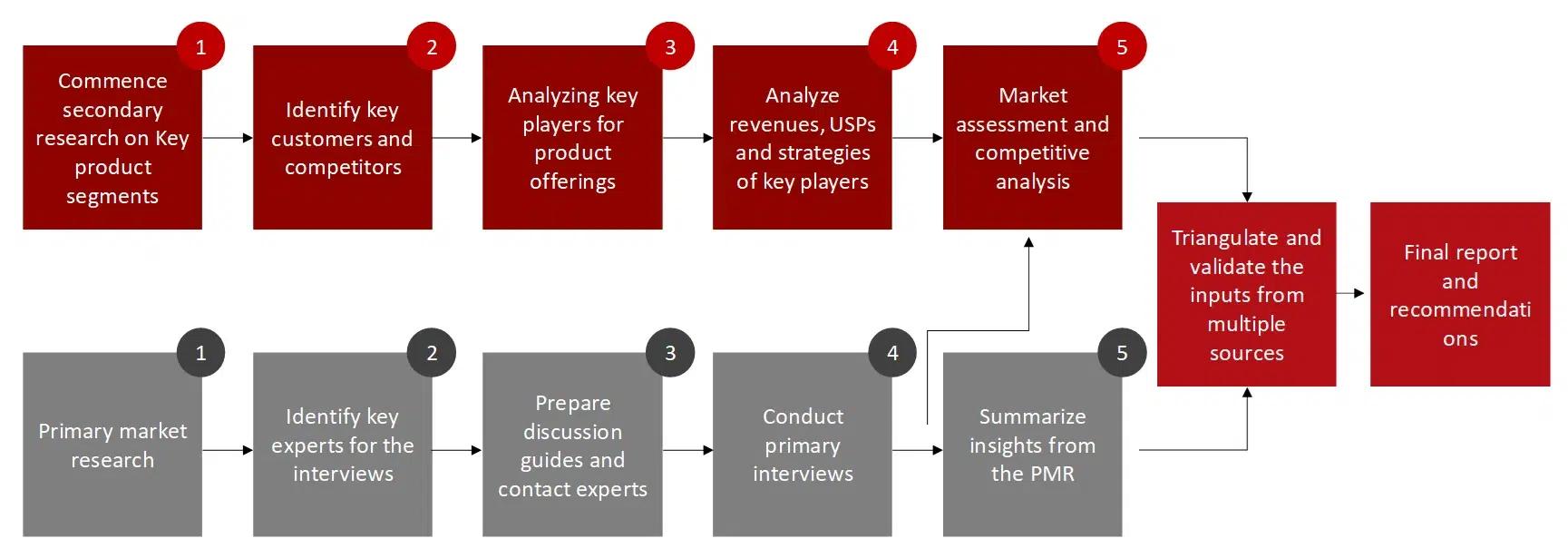
Sources: Wissen Research Analysis
Research Approach
Collecting Secondary Data
The secondary research data collection process involves the usage of secondary sources, directories, databases, annual reports, investor presentations, and SEC filings of companies. Secondary research will be used to identify and collect information useful for the extensive, technical, market-oriented, and commercial study of the multiple sclerosis market. A database of the key industry leaders will also be prepared using secondary research.
Collecting Primary Data
The primary research data will be conducted after acquiring knowledge about the multiple sclerosis market scenario through secondary research. A significant number of primary interviews will be conducted with stakeholders from both the demand side and supply side (including various industry experts, such as Directors, Chief X Officers (CXOs), Vice Presidents (VPs) from business development, marketing and product development teams, product manufacturers) across major countries of North America, Europe, Asia Pacific, and Rest of the World. Primary data for this report was collected through questionnaires, emails, and telephonic interviews.
FIGURE: BREAKDOWN OF PRIMARY INTERVIEWS FROM SUPPLY SIDE
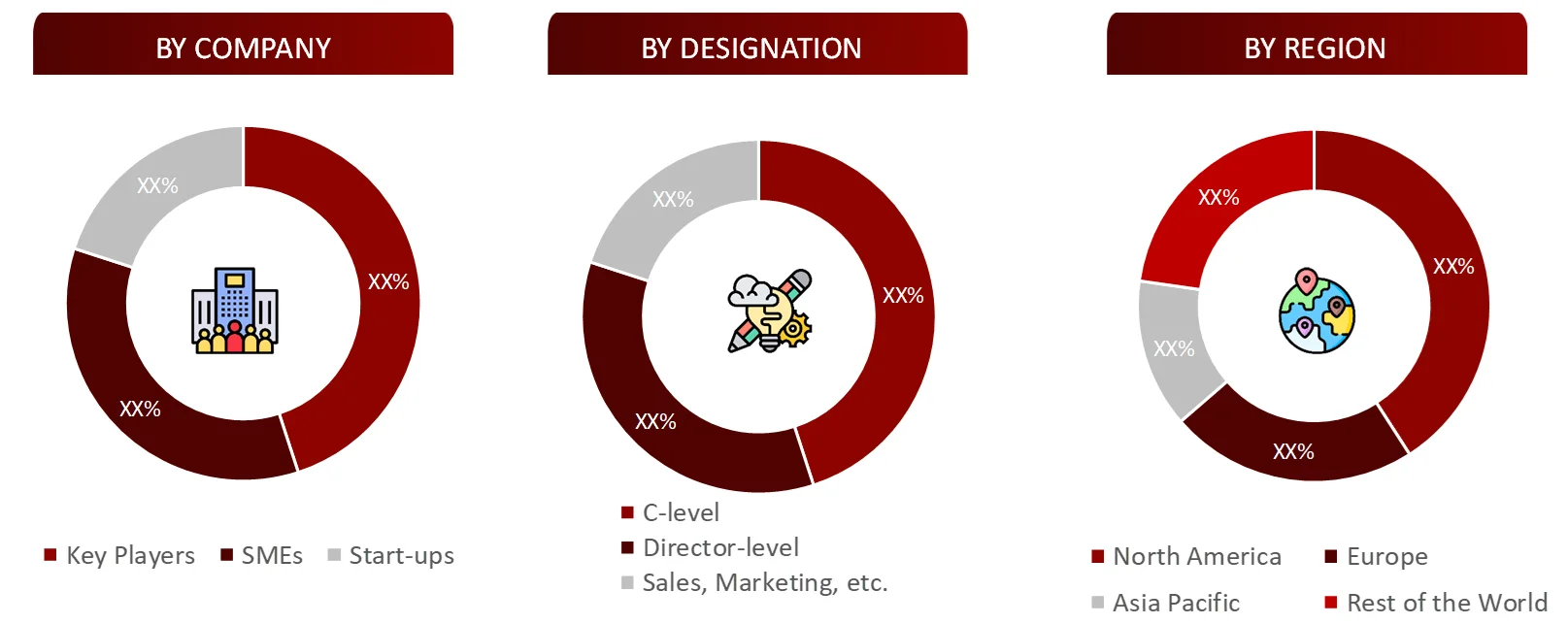
FIGURE: BREAKDOWN OF PRIMARY INTERVIEWS FROM DEMAND SIDE
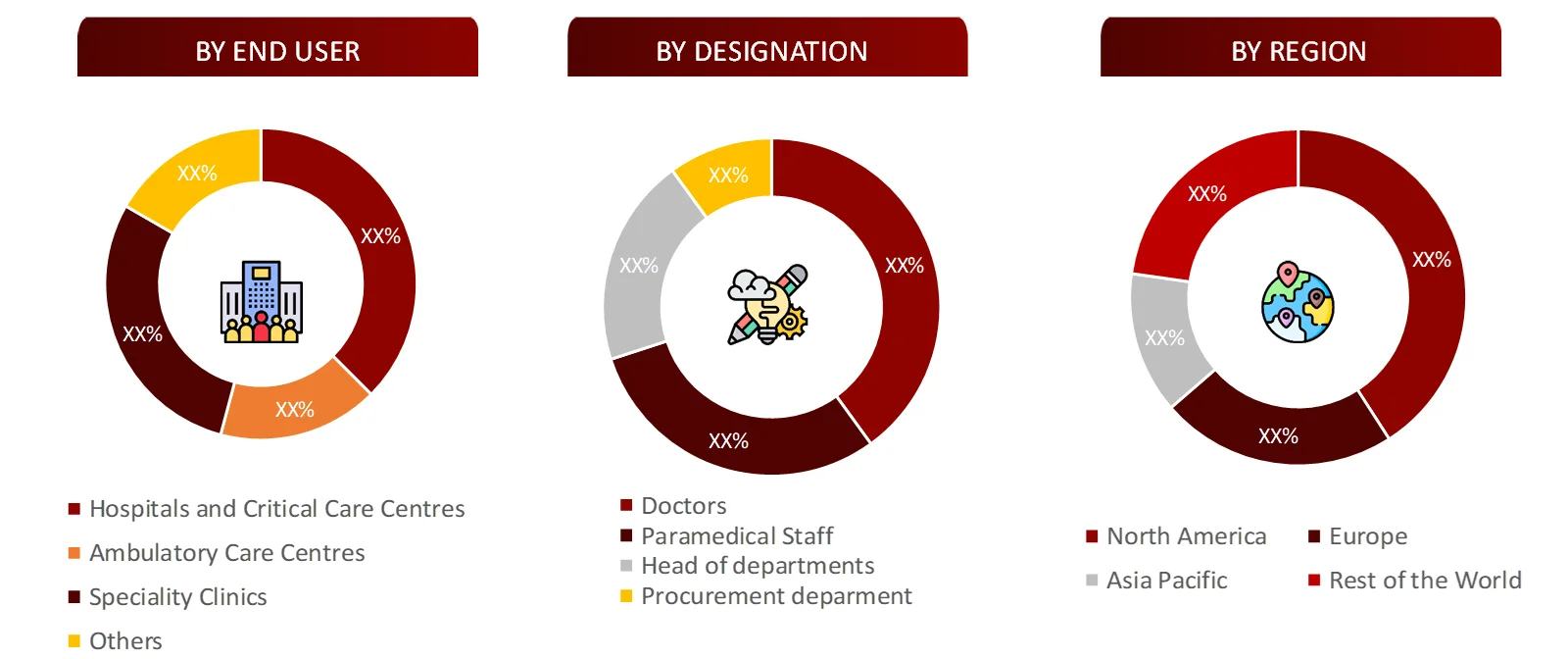
FIGURE: PROPOSED PRIMARY PARTICIPANTS FROM DEMAND AND SUPPLY SIDE

Note: Above mentioned companies are non- exhaustive
Market Size Estimation
All major manufacturers offering various multiple sclerosis will be identified at the global/regional level. Revenue mapping will be done for the major players, which will further be extrapolated to arrive at the global market value of each type of segment. The market value of multiple sclerosis market will also split into various segments and sub segments at the region level based on:
FIGURE: REVENUE MAPPING BY COMPANY (ILLUSTRATION)
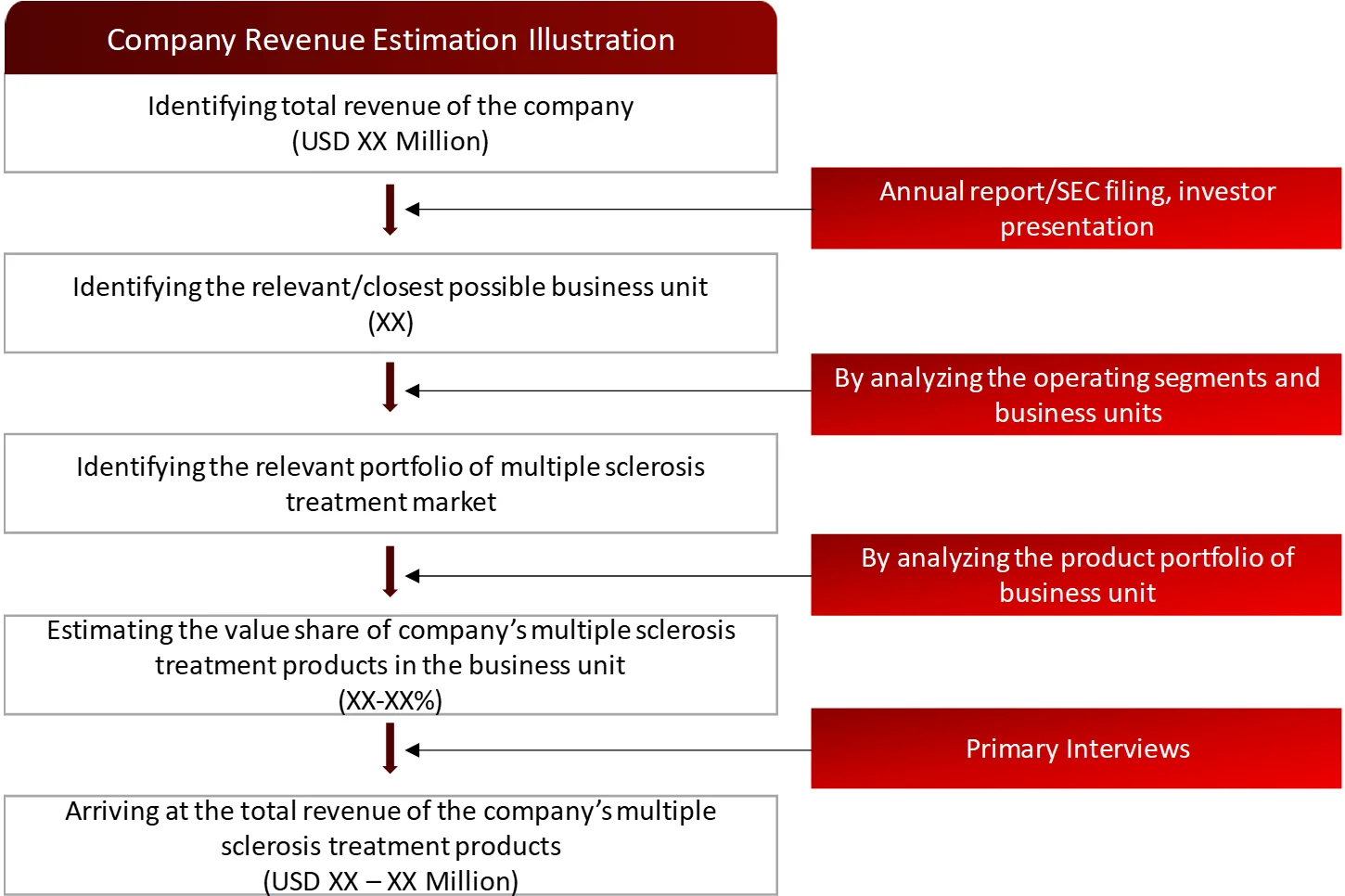
Sources: Company Websites, Annual Reports, SEC Filings, Press Releases, Investor Presentation, Paid Database, and Wissen Research Analysis.
FIGURE: REVENUE SHARE ANALYSIS OF KEY PLAYERS (SUPPLY SIDE)
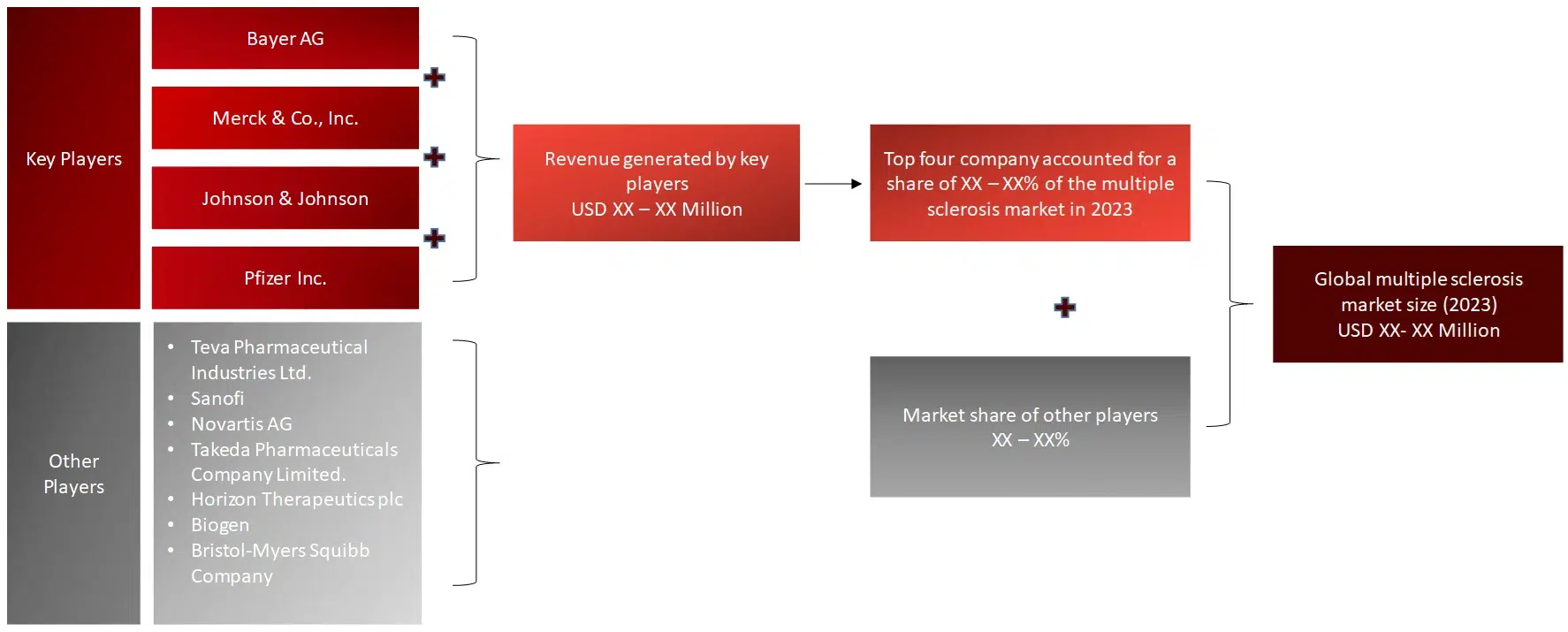
Sources: Company Websites, Annual Reports, SEC Filings, Press Releases, Investor Presentation, Paid Database, and Wissen Research Analysis.
FIGURE: MARKET SIZE ESTIMATION TOP-DOWN AND BOTTOM-UP APPROACH
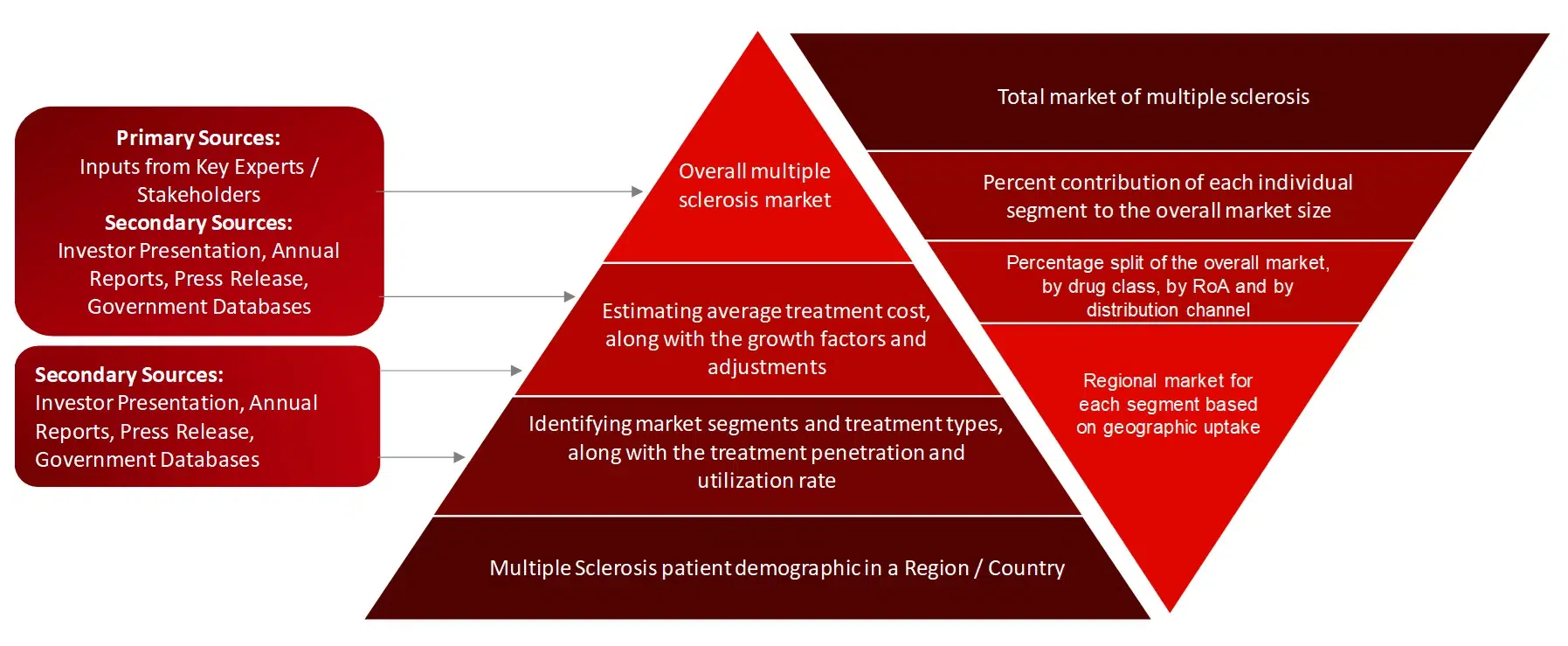
Sources: Company Websites, Annual Reports, SEC Filings, Press Releases, Investor Presentation, Paid Database, and Wissen Research Analysis.
FIGURE: ANALYSIS OF DROCS FOR GROWTH FORECAST
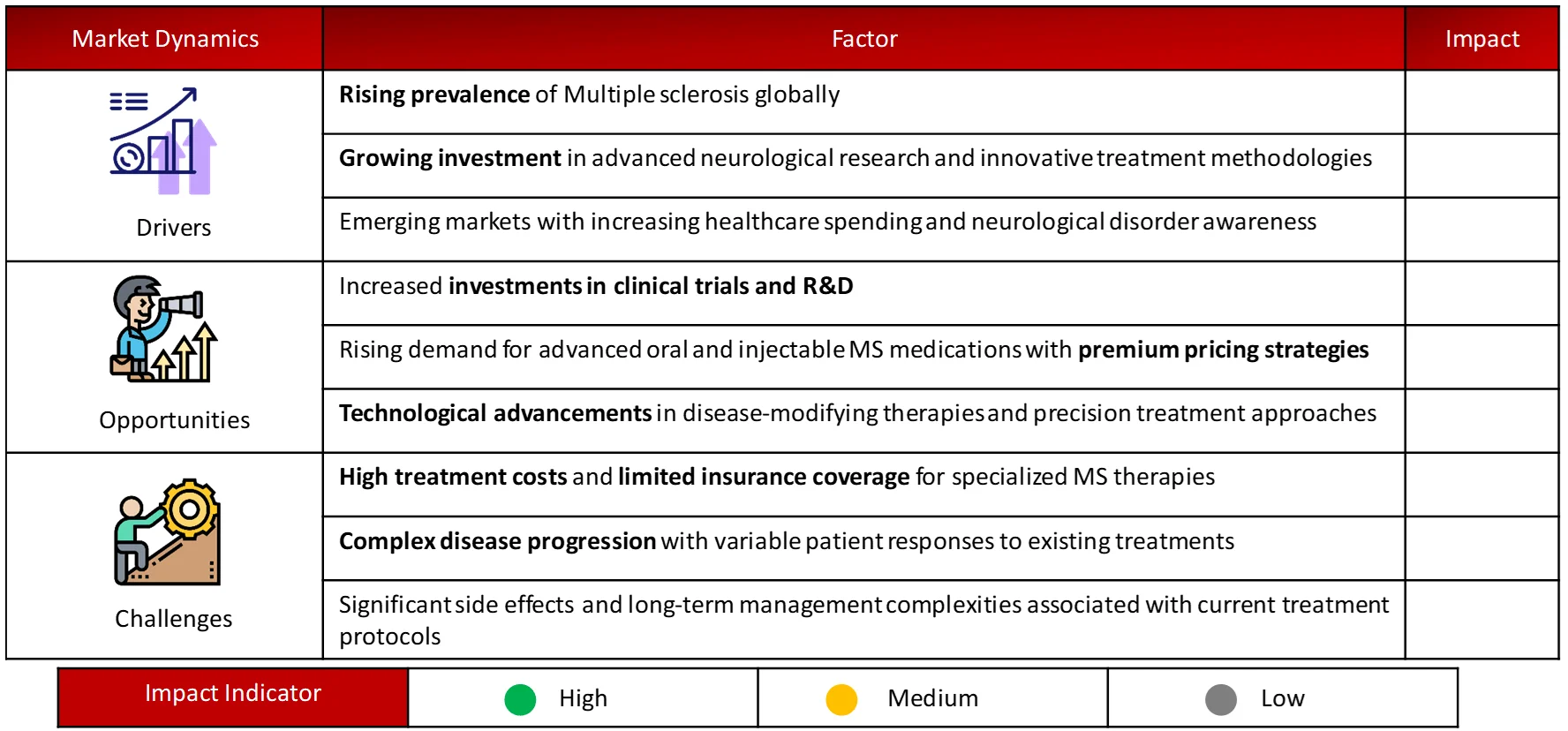
Sources: World Health Organization (WHO), the Organization for Economic Co-operation and Development (OECD), National Center for Biotechnology Information (NCBI), Centers for Disease Control and Prevention (CDC), the Global Cancer Observatory (GLOBOCAN), the National Institutes of Health (NIH), Center of Disease Control & Prevention (CDC), US Department of Health and Human Services, National Institutes of Health (NIH), National Library of Medicine, National Center for Biotechnology Information (NCBI), National Institute of Allergy and Infectious Diseases (NIAID), World Cancer Research Fund International (WCRF International), European Medicines Agency (EMA), The National Medical Products Administration (NMPA), United States Food & Drug Administration (US FDA), Orange book, Purple book, Clinical trials.gov, Pan American Health Organization (PAHO), United Nation International Children’s Emergency Fund (UNICEF), Department of health and Human Services (HHS), The Central Drugs Standard Control Organization (CDSCO)
FIGURE: GROWTH FORECAST ANALYSIS UTILIZING MULTIPLE PARAMETERS
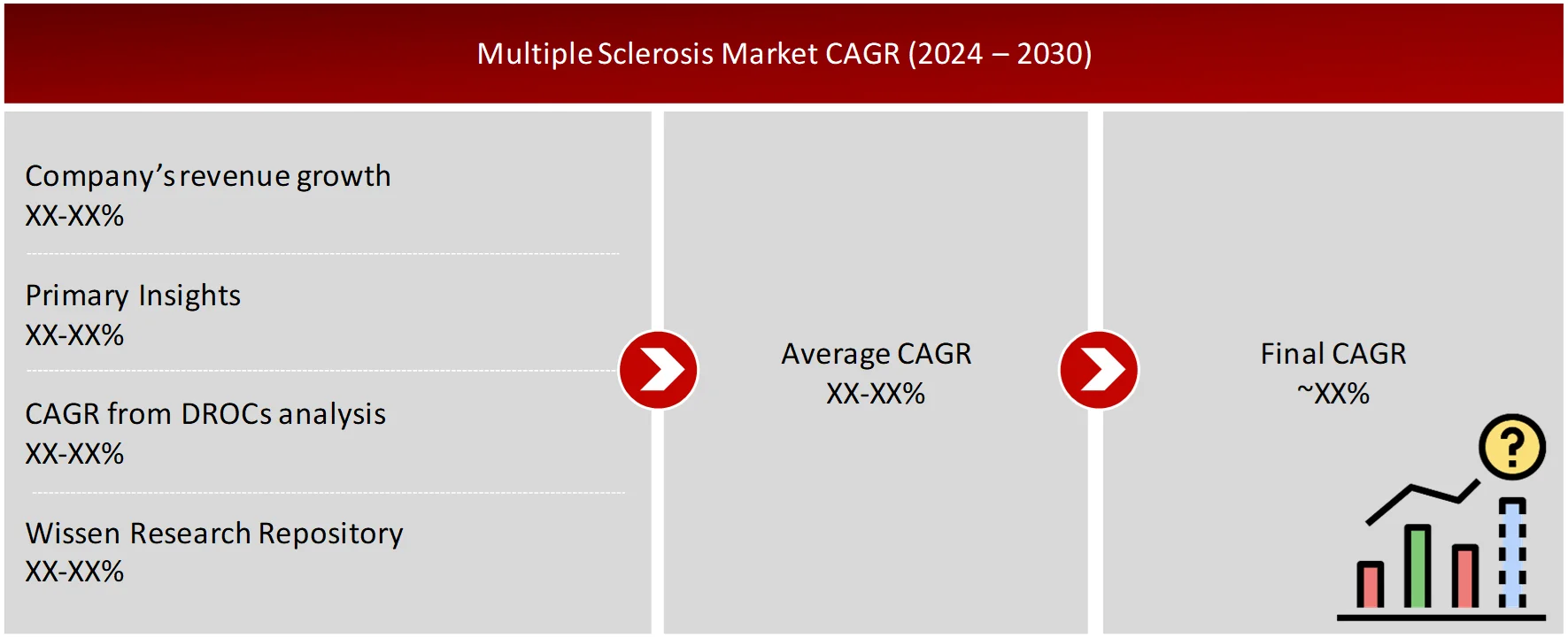
Sources: Company Websites, Annual Reports, SEC Filings, Press Releases, Investor Presentation, Paid Database, and Wissen Research Analysis.
Research Design
After arriving at the overall market size-using the market size estimation processes-the market will be split into several segments and sub segment. To complete the overall market engineering process and arrive at the exact statistics of each market segment and sub segment, the data triangulation, and market breakdown procedures will be employed, wherever applicable. The data will be triangulated by studying various factors and trends from both the demand and supply sides in the multiple sclerosis market industry.
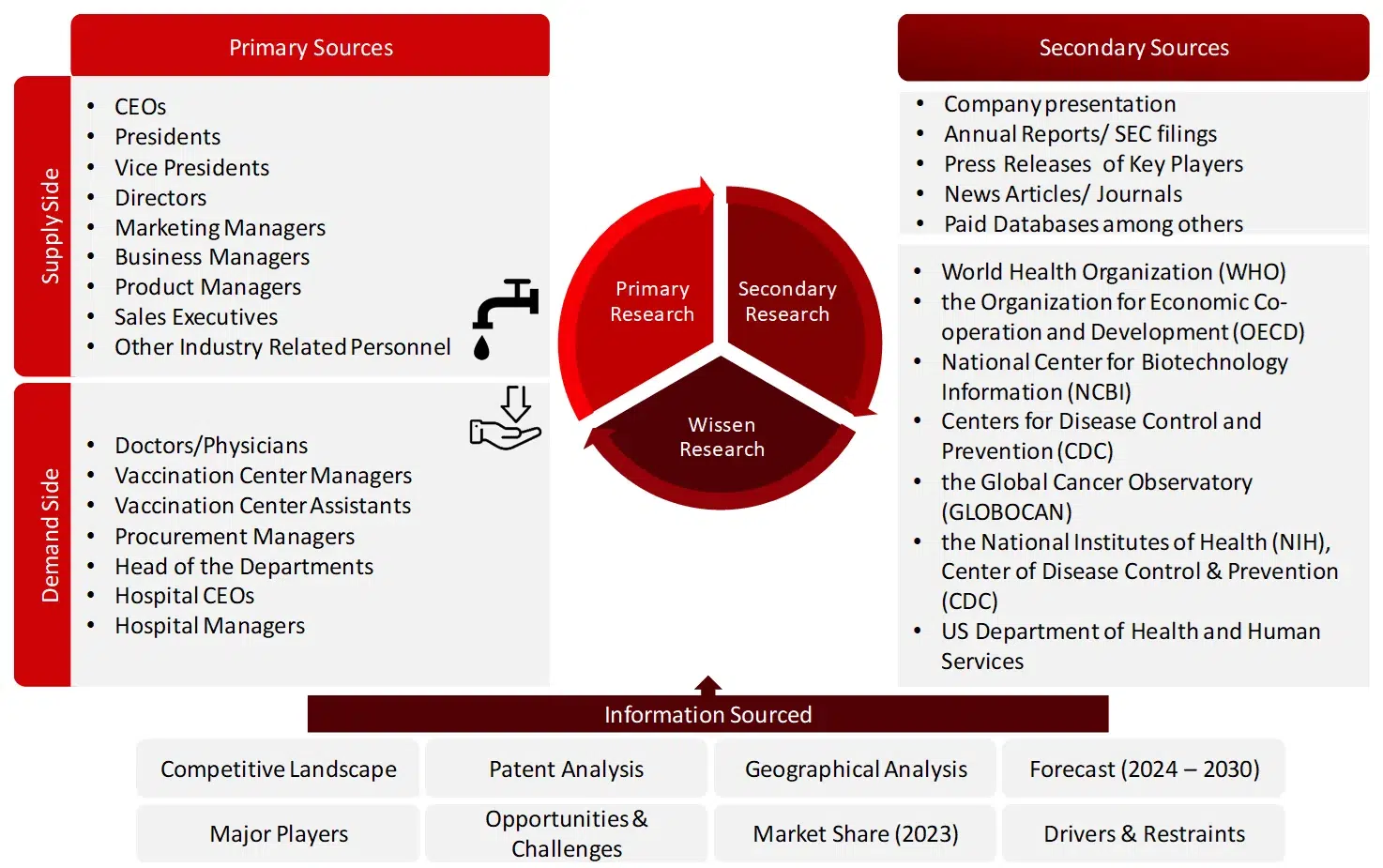
Sources: Company Website, Press Releases, Annual Reports, Paid Data Sources, and Wissen Research Analysis and the above mentioned sources
1. Introduction
1.1 Key Objectives
1.2 Definitions
1.2.1 In Scope
1.2.2. Out of Scope
1.3 Scope of The Report
1.4 Scope Related Limitations
1.5 Key Stakeholders
2. Research Methodology
2.1 Research Approach
2.2 Research Methodology / Design
2.3 Market Sizing Approach
2.3.1 Secondary Research
2.3.2 Primary Research
3. Executive Summary & Premium Content
3.1 Global Market Outlook
3.2 Key Market Findings
4. Market Overview
4.1 Market Dynamics
4.1.1 Drivers/Opportunities
4.1.2 Restraints/Challenges
4.2 End User Perception
4.3 Need Gap
4.4 Supply Chain / Value Chain Analysis
4.5 Industry Trends
4.6 Regulatory Landscape
4.7 Porter’s Five Forces Analysis
4.8 Pricing Analysis
4.9 Reimbursement Scenario
5. Patent Analysis
5.1 Top Assignees in Multiple Sclerosis Market
5.2 Geography Focus of Top Assignees
5.3 Legal Status of Multiple Sclerosis Patents
5.4 Assignee Segmentation
5.5 Network Analysis of Top Collaborating Entities in Multiple Sclerosis Patent Applications
5.6 Technology Evolution in Multiple Sclerosis
5.7 Key Patents in Multiple Sclerosis
5.8 Patent Trends and Innovations
5.9 Key Players and Patent Portfolio Analysis
6. Clinical Trial Analysis
6.1 Overview of Multiple Sclerosis Clinical Trials
6.2 Analysis by Trial Registration Year
6.3 Analysis by Phase of Development
6.4 Analysis by Number of Patients Enrolled
6.5 Analysis by Status of Trial
6.6 Analysis by Study Design
6.7 Analysis by Intervention Type
6.8 Analysis by Geography
6.9 Analysis by Key Sponsors/Collaborators
7. Multiple Sclerosis Market, by Disease Type (2023-2030, USD Million)
7.1 Relapsing-Remitting Multiple Sclerosis (RRMS)
7.2 Primary Progressive Multiple Sclerosis (PPMS)
7.3 Secondary Progressive Multiple Sclerosis (SPMS)
7.4 Progressive Relapsing Multiple Sclerosis (PRMS)
8. Multile Sclerosis Market, by Treatment Type ( 2023-2030, USD Million)
8.1 Disease-Modifying Therapies (DMTs)
8.2 Symptomatic Treatments
8.3 Corticosteroids
9. Multiple Sclerosis Market, by Drug Class (2023-2030, USD Million)
9.1 Immunomodulators
9.2 Immunosuppressants
9.3 Monoclonal Antibodies
9.4 Corticosteroids
9.5 Others
10. Multiple Sclerosis Market, by Route of Administration (2023-2030, USD Million)
10.1 Oral
10.2 Injections
10.2.1 Intramuscular
10.2.2 Subcutaneous
10.2.3 Intravenous
11. Multiple Sclerosis Market, by End Users (2023-2030, USD Million)
11.1 Hospitals and Clinics
11.2 Outpatient Care Centers
11.3 Others (Homecare, Research institutes, etc.)
12. Multiple Sclerosis Market, by Distribution Channels (2023-2030, USD Million)
12.1 Hospitals Pharmacies
12.2 Retail Pharmacies
12.3 Online Pharmacies
12.4 Others
13. Multiple Sclerosis Market, by Region (2023-2030, USD Million)
13.1 North America
13.1.1 US
13.1.2 Canada
13.2 Europe
13.2.1 UK
13.2.2 France
13.2.3 Germany
13.2.4 Italy
13.2.5 Spain
13.2.6 Rest of Europe
13.3 Asia Pacific
13.3.1 China
13.3.2 India
13.3.3 Japan
13.3.4 South Korea
13.3.5 Australia and New Zealand
13.3.6 Rest of Asia Pacific
13.4 Middle East and Africa
13.5 Latin America
14. Competitive Analysis
14.1 Key Player’s Footprint Analysis
14.2 Market Share Analysis
14.3 Key Brand Analysis
14.4 Regional Snapshot of Key Players
14.5 R&D Expenditure of Key Players
15. Company Profiles2
15.1 Pfizer Inc.
15.1.1 Business Overview
15.1.2 Product Portfolio
15.1.3 Financial Snapshot3
15.1.4 Recent Developments
15.1.5 SWOT Analysis
15.2 Merck & Co., Inc.
15.3 Hoffman-La Roche Ltd.
15.4 Sanofi
15.5 Johnson & Johnson, Inc.
15.6 Teva Pharmaceutical Industries Ltd.
15.7 AstraZeneca
15.8 Bayer AG
15.9 Takeda Pharmaceuticals Company Limited.
15.10 Horizon Therapeutics plc
15.11 Biogen
15.12 Novartis AG
15.13 Bristol-Myers Squibb Company
15.14 Others Key Players
16. Appendix
16.1 Industry speak
16.2 Questionnaire
16.3 Available custom work
16.4 Adjacent studies
16.5 Authors
17. References
Key Notes:
Note 1 – Contents in the ToC / market segments are tentative and might change as the research proceeds.
Note 2 – List of companies is not exhaustive and might change during the course of study.
Note 3 – Details on key financials might not be captured in case of unlisted companies.
Note 4 – SWOT analysis will be provided for top 3-5 companies.
The global market for multiple sclerosis was valued at approximately USD 27.6 billion in 2024, and is projected to increase to USD 29.2 billion in 2025.
The global multiple sclerosis market is anticipated to grow at an annual growth rate of 6% from 2025 to 2030 to reach USD 39.1 billion, by 2030.
The major distribution channels in the multiple sclerosis market include Hospitals Pharmacies, Retail Pharmacies, Online Pharmacies, Others. Hospital Pharmacies remained the significant holder of distribution channels market share due to growing significance of disease and the rise in number of indoor patients.
Leading players within the multiple sclerosis market are Pfizer Inc. (US), Merck & Co., Inc. (Germany), F. Hoffman-La Roche Ltd. (Switzerland), Sanofi (France), Johnson & Johnson, Inc. (US)
The market is consolidated at top, comprising 3-5 key players with them holding almost 50% of the market, while it remains lightly fragmented at the lower levels, with numerous small and mid-sized companies operating at regional and national level.
© Copyright 2024 – Wissen Research All Rights Reserved.